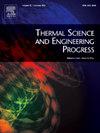Impact of surfactant groups on the stability, thermophysical and phase change characteristics of water-based single and hybrid nanofluid PCMs for cool energy storage applications
IF 5.1
3区 工程技术
Q2 ENERGY & FUELS
引用次数: 0
Abstract
The current work investigates the stability and thermophysical characteristics of various groups of surfactants used in single and hybrid Nanofluid Phase Change Materials (NFPCMs) for cool thermal energy storage (CTES) applications. The single and hybrid NFPCMs were prepared using the oxygen-functionalized GNP and CuO nanomaterials along with three surfactants of CTAB (cationic) SDBS (anionic), and GA (non-ionic) separately, at a 0.1 wt% of nanomaterials in the DI water as a base PCM. Among the different surfactant types of hybrids and single NFPCMs, the SDBS surfactant type of hybrid NFPCM 1 has shown maximum stability, with a smaller average particle size of 227.7 nm and a zeta potential value of −47.3 mV. Furthermore, compared to the basic PCM, the SDBS hybrid NFPCM 1 thermal conductivity exhibits a maximum enhancement of 18.96 % in the liquid state and 31.46 % in the solid state. The latent heat value is maximum dropped by 13.42 % and 10.1 % for GA surfactant type hybrid NFPCM 3 at a heating rate of 5 Kmin−1 during heating and cooling, respectively. Moreover, the thermal stability analysis of TGA shows that both single and hybrid NFPCMs have a suitable peak thermal degradation temperature that is recommended for use in cool energy storage applications. The hybrid NFPCM storage unit integrated with the chiller has the highest stability and thermal properties, capable of achieving environmental pollution redress and energy saving by minimizing the duration of the PCM’s charge.
求助全文
约1分钟内获得全文
求助全文
来源期刊

Thermal Science and Engineering Progress
Chemical Engineering-Fluid Flow and Transfer Processes
CiteScore
7.20
自引率
10.40%
发文量
327
审稿时长
41 days
期刊介绍:
Thermal Science and Engineering Progress (TSEP) publishes original, high-quality research articles that span activities ranging from fundamental scientific research and discussion of the more controversial thermodynamic theories, to developments in thermal engineering that are in many instances examples of the way scientists and engineers are addressing the challenges facing a growing population – smart cities and global warming – maximising thermodynamic efficiencies and minimising all heat losses. It is intended that these will be of current relevance and interest to industry, academia and other practitioners. It is evident that many specialised journals in thermal and, to some extent, in fluid disciplines tend to focus on topics that can be classified as fundamental in nature, or are ‘applied’ and near-market. Thermal Science and Engineering Progress will bridge the gap between these two areas, allowing authors to make an easy choice, should they or a journal editor feel that their papers are ‘out of scope’ when considering other journals. The range of topics covered by Thermal Science and Engineering Progress addresses the rapid rate of development being made in thermal transfer processes as they affect traditional fields, and important growth in the topical research areas of aerospace, thermal biological and medical systems, electronics and nano-technologies, renewable energy systems, food production (including agriculture), and the need to minimise man-made thermal impacts on climate change. Review articles on appropriate topics for TSEP are encouraged, although until TSEP is fully established, these will be limited in number. Before submitting such articles, please contact one of the Editors, or a member of the Editorial Advisory Board with an outline of your proposal and your expertise in the area of your review.
 求助内容:
求助内容: 应助结果提醒方式:
应助结果提醒方式:


